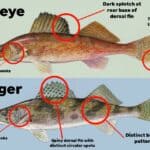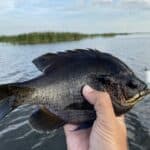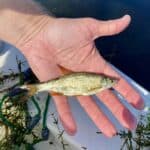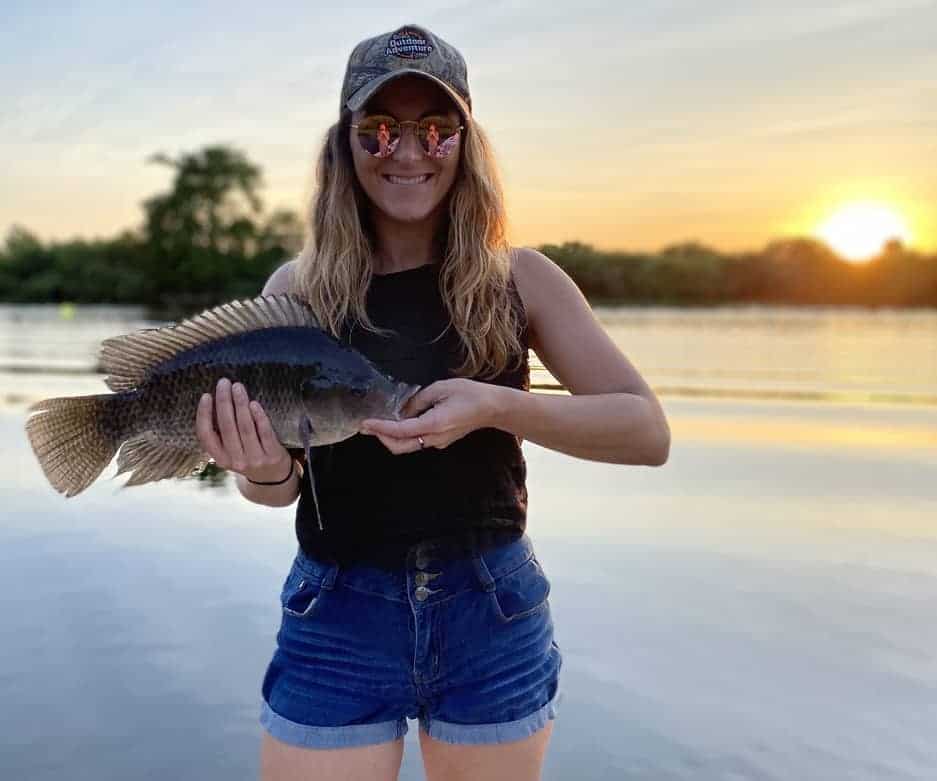
If you fish in an area with warm water or exotic species you may have encountered the Tilapia. These fish are not native to the United States, but they do offer a great angling opportunity in many states and countries around the world.
In this article, I will discuss tilapia fishing in general and give you some tips and tricks for catching them, especially while they are on the bed (spawning).
Table of Contents
How To Catch Tilapia on Beds
To catch tilapia on beds, you’ll need to be stealthy and quiet. Approach carefully so that your shadow does not spook the fish. Cast a small bait, such as a piece of nightcrawler on the edge of their bed, and let it sit. Tilapia are shy, but they will defend their beds and attack anything that lands nearby.
To catch tilapia on beds, you first need to locate them. Tilapia beds look like tiny sand craters along the shoreline of ponds, creeks, or rivers. Beds can be large, between 1-3 feet in diameter and you can generally see a few fish swimming around them.
Tilapia are very protective of their beds, especially when they’re spawning. These fish spawn year-round, as long as the water temperature is over 60°F(15°C).
If you find a tilapia bed and know how to agitate the tilapia without scaring them too much, you have an excellent chance of catching some fish.
When you’ve found the tilapia bed, be careful not to get too close to it. If you scare the fish too much, they’ll retreat entirely, and you’ll miss out on catching them. Stand in the shallow water or on the shore and cast your line towards the tilapia bed without being seen.
Tips
In some lakes, Tilapia are notorious for being plentiful, but very difficult to catch on hook and line. That is why many anglers and outdoorsmen try bow fishing for Tilapia instead (talk about fun!)
- Make sure you hook the bait correctly (more on this in techniques).
- Use a ultralight tackle and flourocarbon leader.
- Wear polarized glasses to see fish below the surface.
- Look for tilapia in shallow, relatively still waters along shorelines.
- Tilapia are more active in the early morning or late evening.
- Keep an eye out for large swirls in shallow water. Tilapia fan beds and create a lot of movement!
Techniques
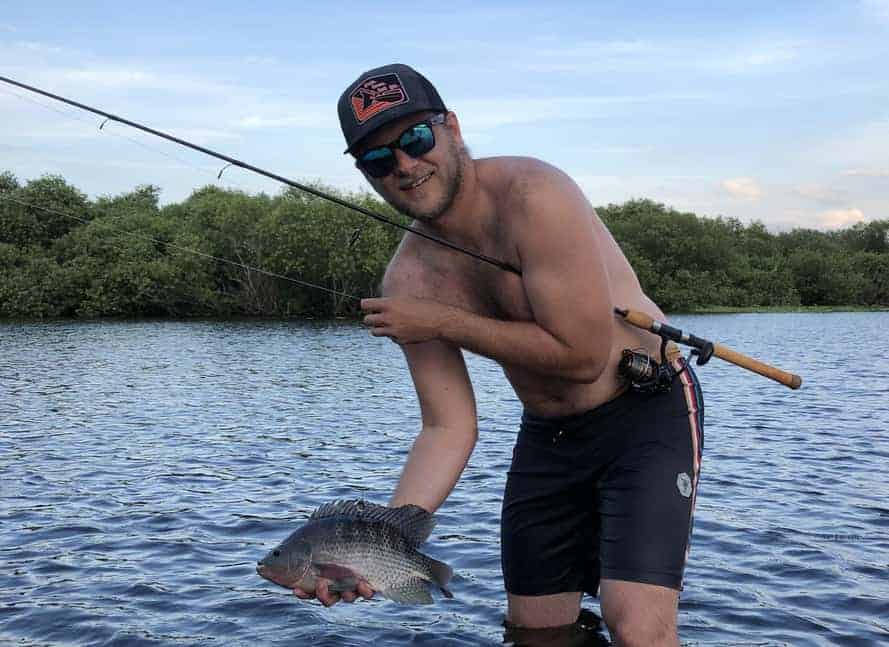
There are a few essential techniques to improve your tilapia catching skills. The two most critical methods are baiting your hook correctly and casting the rod delicately.
Baiting Your Hook
To bait a hook for tilapia, you’ll need to completely conceal the hook into the bait. Tilapia are so line shy and used to eating small prey and vegetation, they may not bite if they see your hook. Try using a #6, #7 or #8 panfish hook. More on the best baits below.
Another TIp: If you’re using food-style bait, you can sprinkle some bait around the area you will be casting. This ‘chum’ method will increase the amount of fish in the area. Many people spread regular bread around the bed and bait their hook with bread balls to be more appealing.
Casting the Rod
When you cast your line for tilapia, you’ll want to be very delicate. This means using a very lightweight outfit with minimal (if any) weight. Avoid large sinkers or aggressive plugs such as topwater or crankbaits- they won’t do any good.
Instead, use a finesse approach and flip a small 1/32nd oz jighead tipped with your favorite bait. Let it sink naturally and be patient!
When the tilapia hooks, wait a few seconds before beginning to reel it in. Tilapia’s mouths are soft and small, so if you reel in too quickly, its mouth will rip, and the fish will get away. Reel it in gently and slowly, without jerking the line around too much.
Baits
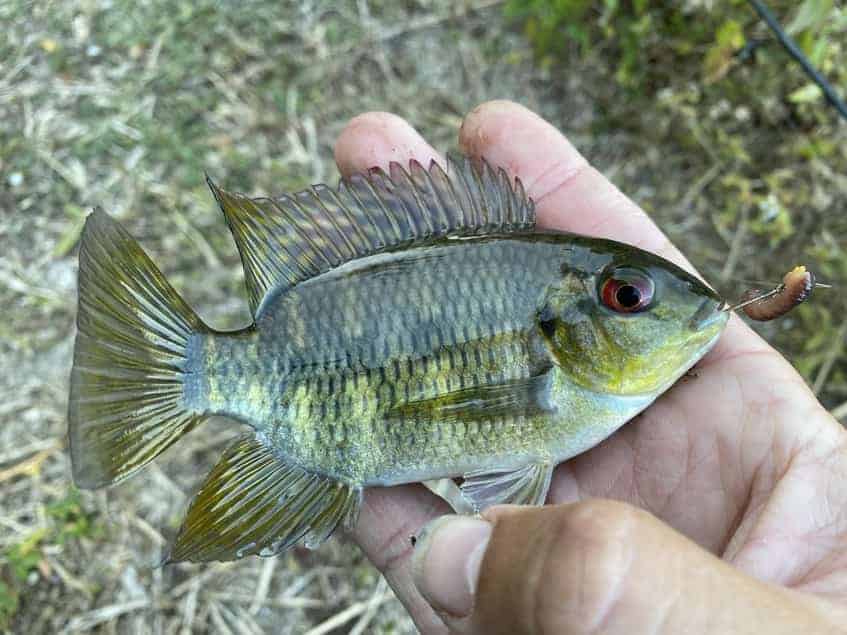
Tilapia are omnivores and can be caught with a variety of baits. In the wild, Tilapia primarily eat insects, mollusks, worms, grubs, and aquatic vegetation. Contrary to popular belief, they are not herbivores although this does make up a large portion of their diet.
Some common baits for tilapia include:
- Corn
- Peas
- Cheese
- Gulp! Maggots (dont worry, they are artificial but work amazing)
- Pieces of worm (nightcrawlers, meal worms etc)
- Small fish
- Fish pellets
However, good old-fashioned bread balls are some of the most effective baits for tilapia in any environment. Simply mash up an old piece of bread and get it a little wet. Break off pieces of the bread and squeeze it around the end of your hook.
Tip: Biscuit dough works very well too! Or make your own by mixing water, flour, and egg. Experiment with the consistency and add attractants such as vanilla, anise, or menhaden oil.
Lures
If you decide to use lures to catch tilapia, make sure you use smaller lures and floats. Tilapia rarely go after larger lures because they only eat smaller fish. I recommend a micro jighead, ultralight beetle spin, or a small 1/6th ounce ned rig with a pink worm.
If you want an extra challenge, try fly fishing for tilapia. They are known to strike most any dry flies lurking above their beds, as well as leech imitations and orange microbead nymphs.
About Tilapia Fishing
The term Tilapia may refer to a number of species in the Cichlid family, although most anglers are referring to the Blue Tilapia or Nile Tilapia.
Native to tropical regions around the world they have been introduced into the United States on purpose and inadvertently over the years.

Tilapia are popular amongst beginning anglers because they are plentiful and easy to catch. You can fish for tilapia with more affordable bait and smaller rods and tackle.
Tilapia are a bit controversial too. They tend to destroy the lakes, rivers, and ponds that they live in and eat all the vegetation. Tilapia breed quickly and overtake the natural population of native species.
In some areas, such as south Florida they have dominated ecosystems and anglers are encouraged to keep as many as possible.
Frequently Asked Questions
Here are some of the frequently asked questions about tilapia fishing:
- What size hook should I use? A size 4 J-hook is perfect for tilapia.
- When are tilapia most active? They spawn year-round but are most active April-July.
- Do tilapia eat meat? Yes, contrary to popular belief Tilapia will eat meat such as small baitfish, worms and insects.
- Can I catch tilapia with a spincast reel? Yes! Spincast reels are great for catching tilapia and a perfect way to introduce kids or beginners to fishing.
- Are tilapia bottom feeders? Tilapia are primarily classified as a bottom feeding fish, meaning they search for food along the bottom 1/3 of the water column.
Conclusion
Tilapia fishing is relatively easy if you know some of the tricks of the trade. Half of the fun is scouting and finding new locations to catch these exotic fish.
Remember: Be stealthy, downsize your tackle, and be patient! Good luck and thanks for reading.
Like this post? Save it on Pinterest.


